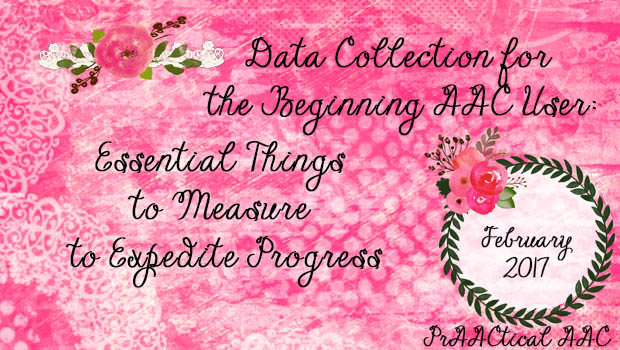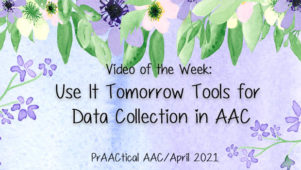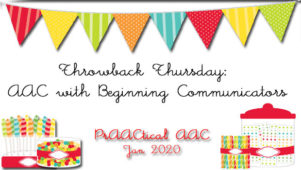Data Collection for the Beginning AAC User: Essential Things to Measure to Expedite Progress

It’s exciting to see more and more teams on the road to implementing AAC in therapy and in the classroom. Often, though, our initial expectations for student progress don’t pan out. Consider these examples.
- Aleksander’s SGD has robust vocabulary that is customized specifically for him. He uses it consistently at snack and lunch time, but rarely uses it in other activities.
- Ariel uses her AAC app to ask for things, make comments, and answer questions but rarely goes beyond the single word level to express herself.
- Jayson had a PECS book for over a year and learned to request his favorite foods but not much else. His team switched Jayson over to a more robust AAC system, and while he learned to communicate for other reasons, he still doesn’t use his communication book very frequently unless he’s prompted to do so.
Do these situations seem vaguely familiar? Helping AAC learners become more proficient communicators is a journey that has twists and turns, stops and starts. We may get excited by the possibilities of AAC systems, encouraged by our learners’ early successes, and then get concerned as progress slows down or even stalls out.
How can we alter the slope of learning and expedite our students’ progress? There are lots of ways to address this, but here’s one of them: Re-tool your data collection to include implementation rather than student performance.
Why? In general, we pay more attention to things that we measure. It’s nerve-wracking to take data on ourselves, but when we move past that, we often find this to be a helpful tool for accelerating student progress. Clearly, we have to continue to collect student performance data, but when we limit ourselves to that, we often miss key reasons for the slow rate of progress. Gathering data on how we implement AAC in addition to how the student is using it, helps us fine-tune our instruction.
There’s lots to think about, of course, with AAC implementation. How should we approach this? Here are some ideas of behaviors we can measure to get us started.
- Frequency of aided language input: This research-supported strategy is something we’ve written about in literally hundreds of posts so regular visitors to this site know what it is and the important role that it plays in language learning. They know how to do it, and may have even taught others to employ this pivotal strategy. Their students may have goals that require this (e.g., “Given aided language input, Jayson will….”). We know that this is a critically important strategy for beginning communicators but how often are we using aided language input when we speak to the student? Tracking our own performance in this area may well reveal gaps in our implementation, and that allows us to focus on it with new energy and commitment. The more WE use AAC, the more our students will use it.
- Number of communication opportunities: Most of our AAC learners need a lot of practice, and unless we are mindful about creating frequent opportunities for them to use their new skills, there’s a good chance that the student didn’t get as many as he/she needs. When progress stalls, a sure way to move forward is to boost the frequency of opportunities. We might have the right ‘medicine’ but are presenting it in a ‘sub-clinical dose.’ Taking data on the number of times our students had clear opportunities to use their target skills allows us to identify any gaps and strengthen the intervention plan. The more opportunities the students have to practice the target skill, the more likely they will improve their AAC fluency.
- Quality of our responses: How we respond to AAC learners can inspire more learning, keep them at the same level, or discourage future attempts. When Jayson says “french fries” at circle time, we could respond in a variety of ways (e.g., “No, we’re not talking about lunch now.” “French fries! Yum! I love french fries.” “Yes! You had french fries last night.” “Fries! That’s a great ‘f’ word!” “Do you like ketchup on your french fries?” “French fries? Oooh! That starts the same as ‘Friday,’ doesn’t it?”). The more accepting and supportive we are in our feedback and responses, the more likely we are to create a positive learning environment.
There are lots of ways we can support better learning in our beginning communicators, and data collection can play an important role. Do you take data on AAC implementation ? We’d love to hear about it.
Filed under: Featured Posts, PrAACtical Thinking
Tagged With: beginning communicator, data collection
This post was written by Carole Zangari





11 Comments
I’m on the look out for good data sheets. Does anyone have ones they recommend?
Vicki, I have a few. Are you looking to track partner skills or are you looking for data sheets for the students?
This post gives a very interesting perspective on data collection. It makes sense because in the end, all of us want the kiddo’s to become better communicators, so analyzing all influences on achievement makes total sense to me.
Are the data sheets Vicki requested on the website? If so, please direct me where. If not, please send me samples, for both tracking partner skills and for sheets for the student.
Thanks for all the great information!
Many thanks.
Terre, I’ll be sharing a form for collecting data on some of the partner skills in a post tomorrow. There are other AAC assessment forms in an earlier post: http://bit.ly/AxForms
Hello,
I am also looking for data sheets. I am using P2Gwith my son , his school shadow and ABA staff also uses it for different reasons. However, I am interested to track the modeling and usage of certain words till they are acquired by him completely. How to go ahead on this?
Tripti, thanks for stopping by to comment. Tomorrow’s post will have a form that may be helpful.
I use my own iOS app, Percentally Pro 2, to collect data for students and communication partners. As an AAC Specialist, I typically use the app to track how frequently that communication partners do aided language stimulation across a variety of communication functions. Percentally Pro 2 has line charts in which I can set a target line, so it’s easy to easy see how the communication partner’s data compares to a recommended frequency. For example, I set the target line at 5 to see if the communication partner does at least 5 total models for a period of 15 minutes. I use 5 as the target because of the YouTube video from One Kids Place Language that recommended aided language stimulation 20x/hour.
Thanks for sharing that, Eric! Do you take data on yourself this way, too? Would love to hear about that experience!
I have not collected data on my own modeling skills, but that would be a good exercise. I suppose I would record a video of myself, then collect the data while watching the playback. It would be interesting to see which communicative functions I model the most and least. For one speech-language pathologist I tracked, I was able to show her how she modeled questions the most, but she did not model any protests.
I asked my daughter’s edu SLP to turn on the Data Logging feature on her AAC for one month last May and one month of this past Dec.. (my daughter had a new 1:1 aide and agency come on board in early fall). While her argument not to do this (at all) is that we are tracking EVERYONE’S use of the device, not just my daughter’s or the aide’s. It included home use by everyone as well. I understand this.
However, I feel there can be some bit of useful information to gather by comparing those month’s data logging info. Presently the SLP does not feel it’s important to review the data log, but invites me to call an IEP meeting just for this purpose, and to discuss anything at that time. Seems ridiculous to call an IEP meeting if there is nothing of concern on the data…. Thoughts? TIA!!
Kathryn, it does seem like there is a more efficient way to get the data logging feature turned on, but if she prefers to do this in an IEP meeting then maybe that is the best way to go. You can always request that data logging be kept on and include that in the IEP. I can’t imagine an SLP not wanting these data. We know that modeling with the device is hugely beneficial to AAC learners, so even though the data does not discriminate between who is using the device, it is enormously useful to gather information on how, when, and how often the SGD is being used. In our university AAC courses, we teach that if you are fortunate enough to be working with a students whose device or app has data logging capabilities, by all means use it!